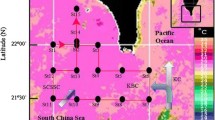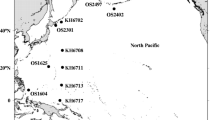Abstract
Copepod communities in onshore and offshore waters show a gradient from primarily near shore to primarily oceanic species. Understanding the transition between these communities is fundamental to determining the range of coastal influence. Copepod communities in the northern South China Sea (nSCS) were studied based on samples collected by vertically towing a net in 10 February–6 March (winter) and 26 August–6 September (summer) of 2004. Calanoida species richness, total copepod abundance, Shannon–Weaver diversity index, and onshore–offshore occurrence of dominant species showed obvious change from onshore to offshore waters. Although the offshore stations had lower abundance than the shelf stations, they had more species and larger diversity index. Abundance of some species (groups) with dominance index >5% (Calanus sinicus, Euchaeta spp., Temora spp., Paracalanus parvus, and Subeucalanus subtenuis) declined from onshore to offshore waters. Warm water species (Pleuromamma abdominalis, P. gracilis, and P. robusta) occurred in offshore waters in both cruises. Station (q-type) cluster analysis in winter and summer separated copepod community into onshore and offshore communities at ~40% level of similarity. The two communities were divided at the position of ~100-m isobath. In summer, C. sinicus occurred in the upwelling area east of Hainan Island, indicating the presence of an oversummering stock of this species.






Similar content being viewed by others
References
Beaugrand, G., K. M. Brander, J. A. Lindley, S. Souissi & P. C. Reid, 2003. Plankton effect on cod recruitment in the North Sea. Nature 426: 661–664.
Berasategui, A. D., S. Menu Marque, M. Gomez-Erache, F. C. Ramirez, H. W. Mianzan & E. M. Acha, 2006. Copepod assemblages in a highly complex hydrographic region. Estuarine, Coastal and Shelf Science 66: 483–492.
Bradford, J. M., 1977. Distribution of the pelagic copepod Temora turbinata in New Zealand coastal waters, and possible trans-Tasman population continuity. New Zealand Journal of Marine and Freshwater Research 11(1): 131–144.
Chen, Q. C. & S. Z. Zhang, 1965. The planktonic copepods of the Yellow Sea and the East China Sea I. Calanoida. Studia Marina Sinica 7: 20–131.
Chen, Q. C., S. Z. Zhang & C. S. Zhu, 1974. On planktonic copepods of the Yellow Sea and the East China Sea II. Cyclopoida and Harpacticoida. Studia Marina Sinica 9: 27–125.
Coyle, K. O. & A. I. Pinchuk, 2005. Seasonal cross-shelf distribution of major plankton taxa on the northern Gulf of Alaska shelf relative to water mass properties, species depth preferences and vertical migration behavior. Deep-Sea Research II 52: 217–245.
de Puelles, M. L. F., D. Grás & S. Hernández-León, 2003. Annual cycle of zooplankton biomass, abundance and species composition in the neritic area of the Balearic Sea, western Mediterranean. Marine Ecology 24: 123–139.
Emery, W. J., A. C. Thomas, M. J. Collins, W. R. Crawford & D. L. Mackas, 1986. An objective method for computing advective surface velocities from sequential infrared satellite images. Journal of Geophysical Research 91(C11): 12865–12878.
Field, J. G., K. R. Clarke & R. M. Warwick, 1982. A practical strategy for analyzing multispecies distribution patterns. Marine Ecology Progress Series 8: 37–52.
Fleminger, A., 1973. Pattern, number, variability and taxonomic significance of integumental organs (sensilla and glandular pores) in the genus Eucalanus (Copepoda: Calanoida). Fishery Bulletin 71: 965–1010.
Hebard, J. F., 1966. Distribution of Euphausiacea and Copepoda off Oregon in relation to oceanographic conditions. Ph.D. Thesis, Oregon State University, Corvallis, OR: 85 pp.
Hooff, R. C. & W. T. Peterson, 2006. Copepod biodiversity as an indicator of changes in ocean and climate conditions of the northern California current ecosystem. Limnology and Oceanography 51(6): 2607–2620.
Hwang, J. S. & C. K. Wong, 2005. The China Coast Current as a driving force for transporting Calanus sinicus (Copepoda: Calanoida) from its population centres to waters off Taiwan and Hong Kong during the winter northeast monsoon period. Journal of Plankton Research 27: 205–210.
Keister, J. E. & W. T. Peterson, 2003. Zonal and seasonal variations in zooplankton community structure off the central Oregon coast, 1998–2000. Progress in Oceanography 57: 341–361.
Kubota, M., 1994. A new cloud detection algorithm for nighttime AVHRR/HRPT data. Journal of Geophysical Research 50: 31–41.
Kuipers, B. R., H. J. Witte & S. R. Gonzalez, 1993. Zooplankton distribution in the coastal upwelling system along the Banc d’Arguin, Mauritania. Hydrobiologia 258: 133–149.
Lamb, J. & W. Peterson, 2005. Ecological zonation of zooplankton in the COAST study region off central Oregon in June and August 2001 with consideration of retention mechanisms. Journal of Geophysical Research 110: C10S15.
Leandro, S. M., F. Morgado, F. Pereira & H. Queiroga, 2007. Temporal changes of abundance, biomass and production of copepod community in a shallow temperate estuary (Ria de Aveiro, Portugal). Estuarine, Coastal and Shelf Science 74: 215–222.
Lee, W. Y., 1971. The copepods in a collection from the southern coast of Oregon, 1963. M.S. Thesis, Oregon State University, Corvallis, OR: 62 pp.
Li, L., 1990. A study on the summer upwellings in shelf waters west to Zhujiang River mouth. Journal of Oceanography in Taiwan Strait 9(4): 338–346 (in Chinese with English Abstract).
Li, L., 2002. Advance in observational studies of upper layer circulations of South China Sea. Journal of Oceanography in Taiwan Strait 21(1): 114–125 (in Chinese with English Abstract).
Li, C., X. Jia & W. Cai, 2004. Diversity of marine zooplankton in the north of South China Sea. Journal of Fishery Science of China 11(2): 139–146 (in Chinese with English Abstract).
Li, K. Z., J. Q. Yin, L. M. Huang & Y. H. Tan, 2006. Spatial and temporal variations of mesozooplankton in the Pearl River estuary, China. Estuarine, Coastal and Shelf Science 67: 543–552.
Liu, G. R., S. J. Huang & T. H. Kuo, 2000. The Atmospheric Correction Algorithm of ROCSAT-1 OCI data, COSPAR2000, Taipei.
Lopes, R. M., F. P. Brandini & S. Gaeta, 1999. Distribution patterns of epipelagic copepods off Rio de Janeiro (SE Brazil) in summer 1991/1992 and winter 1992. Hydrobiologia 411: 161–174.
Mackas, D. L., 1992. Seasonal cycle of zooplankton off Southwestern British Colombia: 1979–1989. Canadian Journal of Fisheries and Aquatic Sciences 49: 903–921.
Mackas, D. L. & K. O. Coyle, 2005. Shelf-offshore exchange processes, and their effects on mesozooplankton biomass and community composition patterns in the northeast Pacific. Deep-Sea Research II 52: 707–725.
Morgan, C. A., W. T. Peterson & R. L. Emmett, 2003. Onshore–offshore variations in copepod community structure off the Oregon coast during the summer upwelling season. Marine Ecology Progress Series 249: 223–236.
Papastephanou, K. M., S. M. Bollens & A. M. Slaughter, 2006. Cross-shelf distribution of copepods and the role of event-scale winds in a northern California upwelling zone. Deep-Sea Research II 53: 3078–3098.
Ramfos, A., S. Isari, S. Somarakis, D. Georgopoulos, C. Koutsikopoulos & N. Fragopoulu, 2006. Mesozooplankton community structure in offshore and coastal waters of the Ionian Sea (eastern Mediterranean) during mixed and stratified conditions. Marine Biology 150: 29–44.
Razouls, C., F. de Bovée, J. Kouwenberg & N. Desreumaux, 2005–2008. Diversity and Geographic Distribution of Marine Planktonic Copepods. http://copepodes.obs-banyuls.fr.
Shannon, C. E. & W. Weaver, 1963. The Mathematical Theory of Communication. Illinois University Press, Urbana.
Sherr, E. & B. Sherr, 2009. Understanding roles of microbes in marine pelagic food webs: a brief history. In Kirchman, D. L. (ed.), Microbial Ecology of the Oceans, 2nd ed. John Wiley & Sons, Inc., New York: 27–44.
Simpson, J. J. & C. Humphrey, 1990. An automated cloud screening algorithm for daytime advanced very high resolution radiometer imagery. Journal of Geophysical Research 95(C8): 13459–13481.
Su, J., 2004. Overview of the South China Sea circulation and its influence on the coastal physical oceanography outside the Pearl River Estuary. Continental Shelf Research 24: 1745–1760.
Tan, Y., L. Huang, Q. Chen & X. Huang, 2004. Seasonal variation in zooplankton composition and grazing impact on phytoplankton standing stock in the Pearl River Estuary, China. Continental Shelf Research 24: 1949–1968.
Tang, D. L., H. Kawamura, H. Doan-Nhu, W. Takahashi, 2004a. Remote sensing oceanography of a harmful algal bloom (HAB) off the coast of southeastern Vietnam. Journal of Geophysical Research (Ocean) 19: C03014.
Tang, D. L., I. H. Ni, F. E. Müller-Karger & I. S. Oh, 2004b. Monthly variation of pigment concentrations and seasonal winds in China’s marginal seas. Hydrobiologia 511: 1–15.
Turner, J. T., 2004. The importance of small planktonic copepods and their roles in pelagic marine food webs. Zoological Studies 43(2): 255–266.
Uye, S., 1982. Length–weight relationships of important zooplankton from the Inland Sea of Japan. Journal of the Oceanographical Society of Japan 38: 149–158.
Uye, S., 1988. Temperature-dependent development and growth of Calanus sinicus (Copepoda: Calanoida) in the laboratory. Hydrobiologia 167/168: 285–293.
Uye, S., 2000. Why does Calanus sinicus prosper in the shelf ecosystem of the Northwest Pacific Ocean? ICES Journal of Marine Science 57: 1850–1855.
Wang, R. & T. Zuo, 2004. The Yellow Sea Warm Current and the Yellow Sea Cold Bottom Water, their impact on the distribution of zooplankton in the Southern Yellow Sea. Journal of the Korean Society of Oceanography 39: 1–13.
Wang, R., T. Zuo & K. Wang, 2003. The Yellow Sea cold bottom water—an oversummering site for Calanus sinicus (Copepoda, Crustacea). Journal of Plankton Research 25: 169–183.
Xu, Z., 2006. Ecological characters of Euchaeta concinna (Copepod) in the East China Sea. Oceanologia et Limnologia Sinica 37(2): 97–104 (in Chinese with English Abstract).
Xu, Z. & Y. Chen, 1989. Aggregated intensity of dominant species of zooplankton in autumn in the East China Sea and Yellow Sea. Journal of Ecology 8(4): 13–15 (in Chinese with English Abstract).
Acknowledgments
This research was supported by National Natural Science Foundation of China (No. 90711006, 90211021, 40976091 and 40811140533) and Chinese Academy of Sciences (kzcx2-yw-226 and KZCX2-YW-T001). We appreciated Dr. Tao Zuo for her help in station cluster analysis. We thank Dr. Hui Zhao and Yang Zhong Zheng of SCSIO for their help in preparing remote sensing images.
Author information
Authors and Affiliations
Corresponding author
Additional information
Handling editor: T. P. Crowe
Rights and permissions
About this article
Cite this article
Zhang, W., Tang, D., Yang, B. et al. Onshore–offshore variations of copepod community in northern South China Sea. Hydrobiologia 636, 257–269 (2009). https://doi.org/10.1007/s10750-009-9955-x
Received:
Revised:
Accepted:
Published:
Issue Date:
DOI: https://doi.org/10.1007/s10750-009-9955-x




